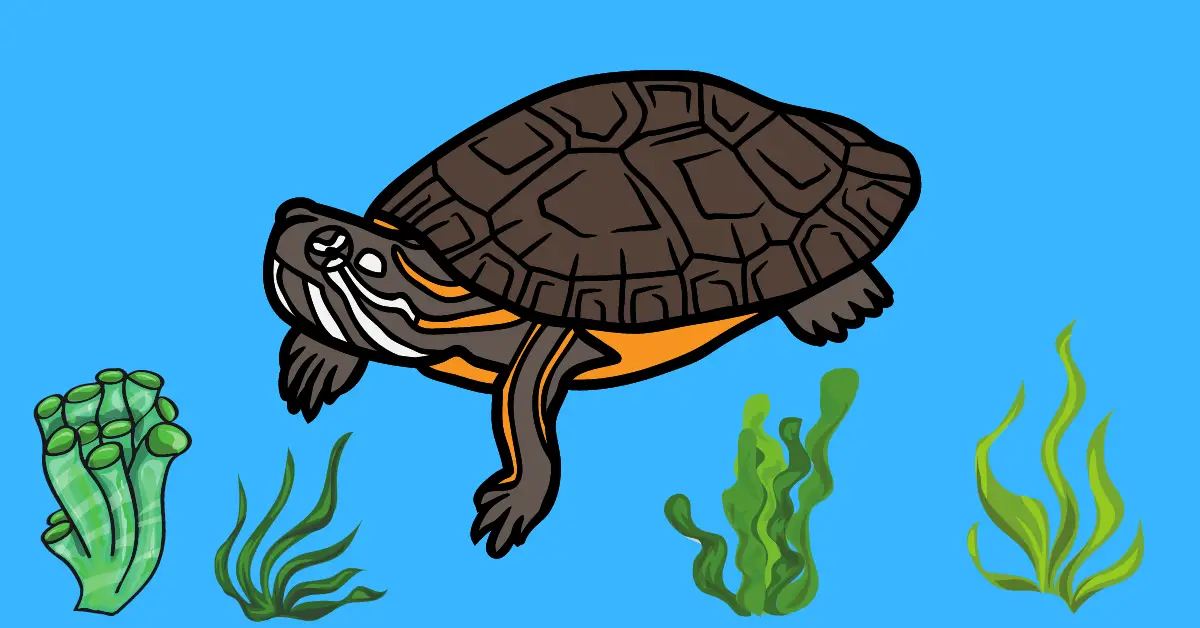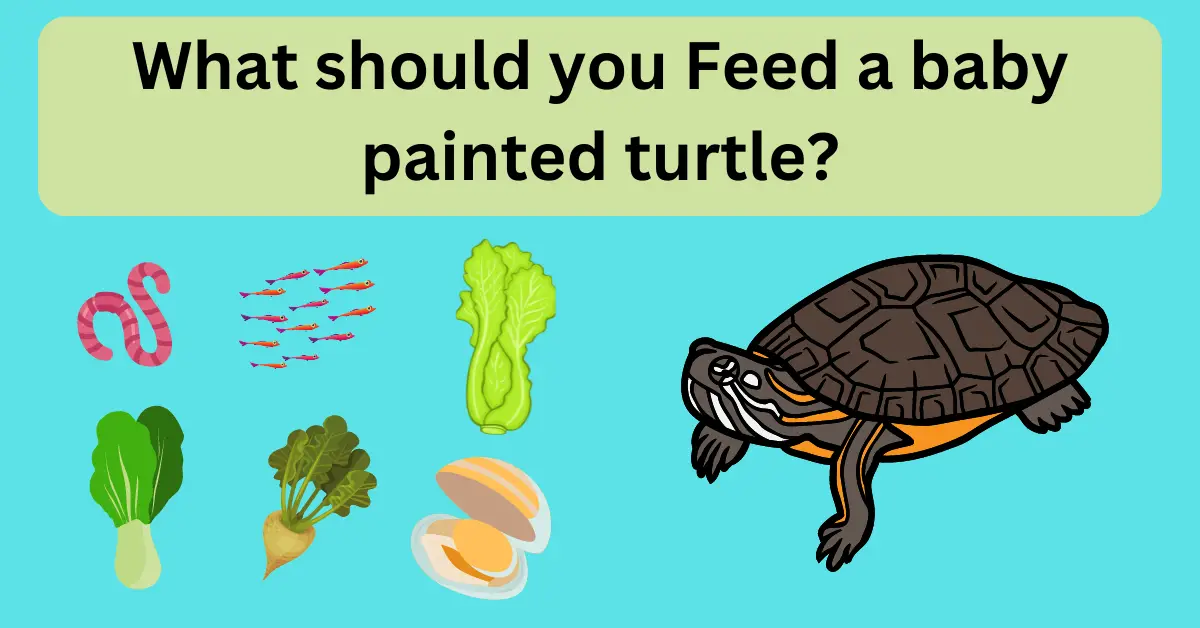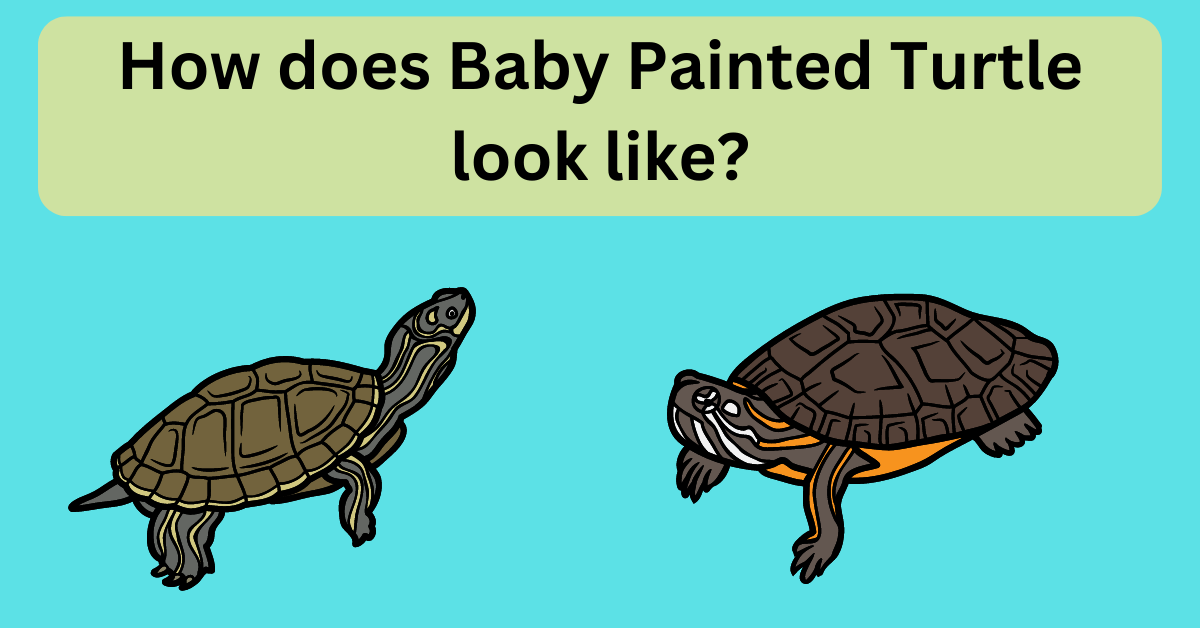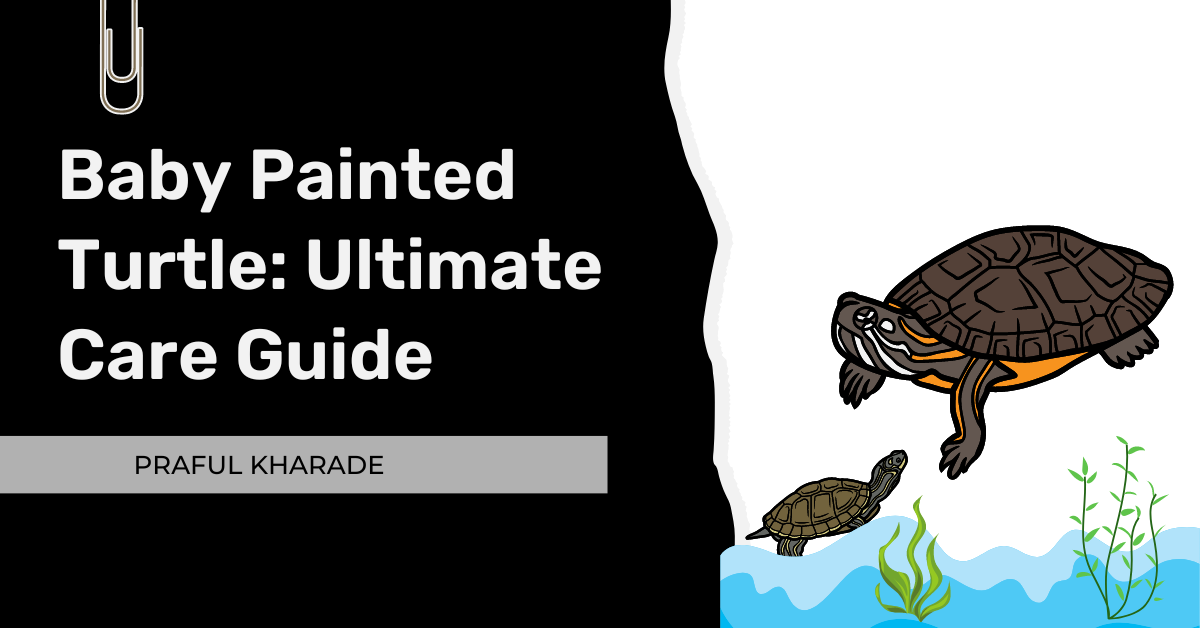One of the most beautiful kinds of pond turtles that live in North America is the Eastern Painted Turtle baby. It’s a good pet turtle for people who are just starting, and it’s easy to keep and care for in an indoor or outdoor enclosure.
Turtles are the most popular turtle species in the world. They are not only beautiful and impressive but they play a major role in our environment by recycling wastewater, eating fish and algae, and providing shelter for birds and other animals.
Baby painted turtles are popular because they have interesting shapes. They are also very colorful and beautiful. They have orange, pink, and yellow skin, which makes them look more like a painting than real turtles.
Baby turtles are cute and cuddly. They look like little turtles with big floppy ears. They can be found in the tropics and subtropics, so they are an easy pet for children too.
Their name comes from their coloring and the way they are often seen in the wild. You can see baby painted turtles in the wild, especially if you go to Florida, Texas, and Louisiana.
Baby painted turtles are found among the trees and arboreal habitats such as canals and streams. They are also often seen in grasslands bordering rivers or lakes.
They will not dig burrows that big, so they can only live there year-round. They have a symbiotic relationship with bacteria, which help them digest their food.
In the spring, when water is warm and the ground moist, some tree frogs emerge from their burrows to bask in the sun. When it’s cooler in the fall, they move back into their winter homes. The eyes of painted turtle hatchlings glow in the dark.
How to Take care of Baby Painted Turtle?

I will be providing a complete guide to caring for baby Eastern Painted Turtle. This guide will help you to raise your baby turtle safely and healthily. You can also use this guide as a reference while caring for your turtle.
Turtle care is a very important issue in the animal world. Most people want a baby turtle because it provides a lot of entertainment, and is very unique but they do not know how to care for them properly.
Whether you are a parent or caretaker, this will teach you how to treat baby turtles safely and healthily.
Most importantly, baby turtles have an amazing ability to care for themselves even after they grow up into adults! Baby turtles are perfect pets for kids and grownups who love nature.
By raising baby turtles we can learn and teach them to survive on their own without human help. Helping them lead healthy lives is a great way to improve our environment, and preserve wildlife.
What does a Baby painted turtle eat?

On a typical day, a baby turtle eats around 15-20% of its body weight in food. To keep the body weight down, it has to absorb water through osmosis. This is done by having an organ called a “gland” that can absorb fluids from the environment and excrete them as waste.
Eastern Painted Turtle babies don’t care what they eat at all. It’s not that hard at all to feed them. These cute little guys eat everything. Eastern Painted Turtle babies eat a lot of different things.
A baby eastern turtle eats a lot of food. They eat insects, worms, and other things that they find in the water.
The turtles can swim very well. Turtle keepers watch them all the time and make sure they are taking in enough food to make it healthy.
Turtles should be fed every 2 to 3 days, so you want to know where they eat most of their food. Pay attention and you will be able to tell if they are not eating well by watching how much water they drink.
Turtles can be sloppy eaters since they must eat with their heads in the water. Some turtle keepers feed the animals in a separate tank, which causes the turtle additional stress because it is handled more frequently.
In the wild, an eastern baby turtle eats a lot of bugs. It is not afraid of snakes or other predators. It lives in the water and does not like to be disturbed.
They come out from their shells at night to feed on small insects, snails, and worms that are swimming around on the water surface.”
They need good nutritional support that includes vitamins, calcium, and proteins in their regular diet. Give them a balanced diet that includes most of the nutrition.
Calcium is most important for turtles. The reason why they need calcium is that they need calcium to build their bones and shell.
Hence, You will need to include calcium in your diet for sure. Never overfeed them as overfeeding may cause trouble while swimming.
The Baby painted eastern turtles are omnivores in nature meaning they can eat both plant and animal matter. However, feeding them a mixed diet is important since it provides different nutritional values.
Some common types of plant and animal materials baby painted turtles eat
Plant Material
- Aquatic Plants: You can feed them plant materials such as Water Lilies, Water Hyacinth, Duckweed, Anacharis, Water Lettuce, Water Fern, Pondweed, Water Starwort, Hornwort, Water Milfoil, and Frogbit.
- Vegetables: You can also feed your baby eastern painted turtle, some vegetables that include Zucchini, Squash, Collard Greens, Beet Leaves, Endive, Romaine, Red Leaf Lettuce, Kale, Escarole, Mustard Greens, and Dandelions, and some fruits like banana. You can also include plants like parsley, dandelion greens, romaine lettuce, red leaf lettuce, collard greens, apples, berries, and carrots. They pretty much eat most plant-based foods. Leafy vegetables contain some good nutrition hence, it is recommended you feed them once every week or so.
Animal Matter:
- Live Foods: Baby eastern turtles eat shellfish, live insects, and small crustaceans. Baby turtles eat a variety of different things. They also eat insects and small fish, but the most common food is water.
- Frozen Foods: Eastern Painted Turtles eat a variety of things, but when they are young, they eat mostly meat. They are happy to eat many different kinds of food. There are commercial diets, like those made by Zilla or ReptoMin, that you can buy. They can also eat feeder fish, feeder crickets, earthworms, krill, blood worms, and even ghost shrimp and crayfish every once in a while.
What Does a Baby Painted turtle look like?

In this section let us discuss what the eastern baby painted turtle looks like.
The baby painted turtle has a dark brown or black body with a yellow head and orange to red tail. It is found in the southeastern United States, Mexico, and Guatemala.
Eastern Painted Turtle babies are small. They can grow to be up to 6 inches long. The markings on these semi-aquatic turtles look like they were “painted.”
The inside of their black shell (carapace) is red. The plastrons on their bellies are bright yellow. On their black skin, there are also yellow and red lines with ribbons.
This turtle uses its long legs to walk slowly across the bottom of the water, pulling its body behind it.
The painted turtle’s head has a large snout with a wide mouth. Their jaws have a bone in the upper jaw, which is used to crush turtle food.
The painted turtle’s eyes are large and round with black pupils that turn white when they close. These turtles blend in well with the ground in their habitats.
Painted turtles live for about 20 years. They can be both male and female as juveniles, but this changes as they grow up.
Male painted turtles become more colorful when they are ready to mate and females become drab when they are ready to lay eggs.
The males become less colorful than the females and their colors change again when they die. Some species of painted turtles have grayish brown with a dark stripe along their back, a black head, and large triangular-shaped plates on each side of their body.
They are also known for their bright coloration during mating season when the male has bright orange or yellow spots on his head and throat.
Painted turtles can be very aggressive when they feel threatened so it is important to not handle them.
How to set up a Tank for a Baby Painted turtle?

Keep it in a tank with enough space for the reptiles. They will have fewer chances of escaping if they are kept in a large cage or undercover.
Provide plenty of proper materials for them to eat, including dry food, lots of water, and substrates that are not too abrasive.
Shelter them from rain or sun. They will soon get used to the cold if it is not provided for a long time. Treat them gently and make sure you do not tear their skin when bathing them or cleaning their shells.
Water
Your painted turtle habitat must contain water because the painted turtle is found in and around bodies of water like rivers, streams, and ponds.
The diameter of the turtle’s carapace should be at least twice as deep as the water as a general rule of thumb.
For instance, water should be at least 12 inches deep for a turtle with a 6-inch body. To keep the water clean, you need also to have a decent filter.
Insects will not only harm your habitat but also destroy it because they are attracted to warm temperatures and they like mud as food.
These bugs do not care at all about your turtle’s habitat, so you should not bother with them. Your turtle’s tank needs to be kept clean while being kept in it since it should be clean all the time.
You don’t want to attract other species of bugs to your turtle’s tank. This will ultimately affect your reptile’s health and you may have to deal with their death as well if you can’t control them, or if they fail in keeping themselves clean.
If there are any algae or bacteria in your tank, this effect can be reduced by changing the filter regularly or placing a light above your turtle’s tank with a UV lamp.
Substrate
No substrate is required for the bottom, but if you desire rocks or sand for aesthetic purposes, make sure the pieces are too large for your turtle to try to eat or swallow.
Should you keep Plants in your tank with a Baby painted turtle?
Whether real or fake, your turtle will enjoy hiding in plants. However, living plants are frequently destroyed by painted turtles, so be ready to replace them.
You can also include driftwood or artificial hiding caves that are available from the nearest pet store.
Hiding Place for Baby eastern painted turtle
A painted eastern turtle needs an underwater hiding location in an aquarium, just as it does in the wild. Whether you opt to use pebbles, driftwood, or a pre-sculpted cave from the pet store, there are several options for creating a submerged hiding location.
Make sure they won’t get stuck in there, as that could cause them to drown. Needing a constant source of water, turtles like to stick close to the surface.
A submerged hiding spot with an adequate surface area will be ideal for them. Since you don’t want your turtle swimming around inside a cave, it is imperative that the cave is non-reactive and does not harbor any live organisms.
Growing a plant in the cave is also a great idea. If you take care not to suffocate your turtle, this can be a great source of calcium and nutrients.
It will give you some control, allowing you to monitor the turtle’s health slowly while growing inside their new home.
You can make sure your turtle’s growing inside is safe. As long as you don’t put your turtle outside when it is raining or snowing, they will be fine.
Just make sure that you have a well-ventilated area away from direct sunlight and dampness. Also, always keep the tank clean to avoid parasites and other diseases.
How to Set up Basking for Baby painted turtle?
A basking platform, boulders, or a piece of driftwood can all provide the dry land your turtle needs to absorb some rays.
To aid in temperature regulation, a basking lamp should be placed there as well. Although painted turtles can survive out of the water for several hours at a time, they need to be returned to the water as soon as possible.
Turtles need to be handled for at least a few minutes to be comfortable. It is important to rub along the shell with a soft cloth or towel after handling, lest it gets into their eyes.
Once your turtle has basked in the mild sunlight or basking light, it can bask on rocks or other objects in the water without harm.
After your turtle has taken a nice long soak in the sun, it can be time to get them in the water. Make sure they have plenty of safe breathing room before putting them into their flippers (this is called “showing off” or “diving”) and scooping them up.
A turtle’s shell is a major source of its heat retention. As the turtle sheds and grows, its carapace shrinks to allow the young turtle to grow larger.
The shells are made from calcium carbonate, which helps keep them rigid and strong enough for the creature to survive in water for extended periods.
Lighting setup for baby eastern painted turtle
To keep healthy, your turtle will require daily lighting, especially UVB lighting. This light is distinct from the heating element, which may also provide light.
You should run the light on a normal day/night cycle, with the light turned off in the evenings. and on a later night cycle which is when the turtles are active.
Without UVB lighting, a turtle is more susceptible to parasites, particularly mites and ticks.
You can purchase a UVB flashlight for about $20. Keep in mind that the light is not targeted, so you may have to aim it at a different part of the turtle’s body to see the results.
During the winter months, your turtle will need extra care. If you are leaving your turtle at home during these months, it is best to take them inside at night as well.
This will help keep them warm while they are waiting for their caretaker to come back home!
Temperature
Picking up the right temperature for the baby eastern painted is equally important to resemble their natural habitat.
As the tank is divided into different “regions,” the temperature needs to change accordingly.
To get the water to the ideal temperature of 75 to 80 degrees Fahrenheit, a submersible heater may be necessary.
The ideal temperature for the basking area is between 85 and 95 degrees Fahrenheit. The air temperature in the rest of the tank, above the water and away from the basking area, should be between 80 and 75 degrees Fahrenheit.
As the baby grows, it will need more space and a bigger tank. A larger tank will allow for room for an overhang to keep the water cooler.
The water temperature will vary depending upon the ambient temperature in your home. Make sure that your tank is not exposed to very cold temperatures, like freezes or winters.
Occasional frost may be OK if you want a tropical aquarium, but during winter months when nighttime temperatures drop below freezing, the chances are higher of damage from heavy ice build-up.
Dense vegetation in your aquarium will help collect water in the tank and dissipate evaporation, so be sure to do regular water changes.
What is the Best Tank size for a Baby eastern painted Turtle?
Because of their aquatic preferences, painted turtles require a spacious aquarium.
A little turtle or hatchling needs a tank that holds at least 15–20 gallons of water. Add five gallons of water for every additional little or young turtle you have.
You’ll need a tank with at least 20 gallons of water for one adult turtle, plus another 10 gallons for each additional turtle, plus extra room for the turtles to do things outside of the tank.
If you are doing a temporary, 10-gallon tank for the turtle’s temporary habitat and have the space to keep it in your home, then this is fine.
But if you are trying to set up a “long-term” environment in your home and do not have the extra space or money for a 20-gallon tank, then try to find a 10-gallon tank, or better yet, try to get a smaller turtle.
This species primarily lives in the water but occasionally climbs onto land, and may occasionally enter buildings.
However, they are not adapted for life on land and will die if moved from their natural habitat. Painted turtles do best when kept in aquariums that are at least 20 gallons in size.
If your home does not have the extra room for a tank that large, then try to get a smaller turtle or aquarium.
What type of tank should you prefer?
Your baby eastern painted turtle will be fine in a regular glass aquarium or a strong plastic tote as long as it has enough water, space, and a place to bask.
They can also live in a pond outside as long as it is cleaned and filtered regularly and has both sunny and shady spots.
How to take care of Baby painted turtles’ Health?
- The Eastern baby painted turtle can live up to 50 years in the wild. However, in indoor conditions, it can live up to 20-25 years with proper care and habitat.
- To make sure the baby painted turtle lives a healthy lifestyle it is important to keep the water clean and free from any bacteria and algae.
- Feed them a mixed diet of food as mentioned in this article above. As turtle is omnivores in nature you can feed them both plant and animal matter.
- Always monitor and check the temperature of water to make sure it aligns with the recommended temperatures mentioned above.
- If you’re thinking about getting a painted turtle, you should make sure there’s a vet in your area who knows how to treat reptiles and turtles in case your turtle gets sick. When they are sick, their eyes swell, bubbles come out of their noses, they get wounds, their breathing gets hard, they lose their appetite, and they have trouble swimming or moving.
- Feed them live feeder fish once in a while as it keeps them healthy and fit.
- Provide them with a proper lighting setup for them to bask.
- Clean the tank properly to remove the formed algae on the surface of the tank as this promotes bacterial formation.
Follow the above-mentioned points and keep them healthy.
How to Handle an eastern Baby painted turtle with care?
Does Eastern baby Painted Turtle Hibernate?
Baby painted turtle Price
The average price of a Baby painted turtle is $80 to $120 depending upon the availability and breeding season. It is estimated that there are more than 2,000,000 Baby painted turtles in North America in total.
As a result of their popularity and availability, the price at which Baby painted turtles are sold is fluctuating continuously depending on various factors.
Also, In some countries, it is illegal to buy turtles. Hence, make sure you check before getting one.
Baby painted Turtle Care
The Eastern painted turtle is very sensitive to sunlight, so it needs to spend a lot of time underwater to stay healthy. It also needs to find food and shelter at night, so it spends much time on land during the day.
The baby eastern painted turtles don’t get along with other animals. They can live together with other painted turtles and other turtle species that need the same kind of enclosure.
Most of the time, the baby eastern painted turtles don’t fight or make a mess with their tank mates. But both men and women can be territorially aggressive.
As long as they have enough space and places to hide, they stay calm and quiet. Territorial aggression can happen when a habitat is too small or doesn’t have enough places to hide.
They don’t need love and attention from people the way other pets do. So, they shouldn’t be handled too often because it can hurt their health.
It is important to wash your hands before and after handling a baby eastern painted turtle because they often have salmonella.
Baby painted turtle size
The average adult Eastern painted turtle in wild has a length between 76 and 100 mm and it weighs between 1.5 – 4 kg.
It, however, is bigger than the long-necked painted turtle, which is only 74–100 mm in length and can weigh around 2 kg.
The short-necked painted turtle is a southern species and has been recorded in Costa Rica, Nicaragua, and Panama.
The size of this species also depends upon the living environment and habitat. The adult male is large for a freshwater turtle with a fully grown body length usually between 1 inch to 2.5 inches (approximately 25 to 55 mm).
Females are smaller and tend to be shorter-lived, reaching a maximum length of around 1 inch (25mm) long.
Baby painted turtle Breeding
The breeding season of baby painted turtles in wild usually begins in May or June, depending on local conditions.
After mating, the female lays eggs every 2–3 days although some females may continue to breed for several months after laying.
As is the case with most temperate species, eastern painted turtles can only breed in the spring and summer.
So, baby turtles that have been raised in captivity are usually available from May to September. During this time, most pet stores will sell eastern painted turtles.
Should you keep Baby Painted Turtle?
Eastern painted turtles are one of the most often kept pets by both experienced and beginning turtle owners. They are quite hardy, with a lifespan of up to twenty years, and can make a great pet for beginners.
They are not difficult to find in the wild, so even the inexperienced owner might be able to keep an eastern painted turtle as a pet.
Caring for an eastern painted turtle is relatively easy. It needs a shallow water dish to drink from and a large container of water in which to swim.
Eastern painted turtles will sometimes jump out of the water, so owners need to keep this tank well-planted with aquatic plants that their pets cannot eat.
Eastern baby painted turtle is a popular pet among people in the US. However, there are many risks involved with owning one of these turtles.
There are a lot of benefits that come with owning an eastern baby painted turtle but there are also risks involved with owning one.
Some of the risks include:
- The turtle may be too large for your home and you may not have enough space to keep it properly.
- You may not have enough time to care for your turtle properly as they require a lot of attention and time.
- You may not know how to care for your turtle properly and end up harming it or causing it harm.
- You might not know what you are getting yourself into when you decide to buy an eastern baby painted turtle as they can live up to 20 years in captivity.
- The Eastern baby painted turtles are illegal in Canada, so if you live there, you cannot own one.
- These turtles could be aggressive if not taken care of properly, as they can bite or scratch.
- It is illegal to sell eastern baby painted turtles in some countries. so, be sure to check it if you intend to own one.
Some of the benefits that come with owning an eastern baby painted turtle are
- These turtles can live up to 20 years in captivity.
- They are very interactive and fun to watch.
- They are the second fastest moving tortoise, beating out the western hinge back tortoise.
- A lot of people enjoy watching and feeding them.
I hope you enjoyed reading this article!
Happy Turtle keeping!


Painted Turtles are fun to watch while they swim and make great pets overall since they’re diurnal and friendly. They require a lot of setup and work to care for, but it’s worth it. Great share!
Remarkable issues here. I’m very satisfied
to peer your article. Thank you so much and I’m looking ahead
to touch you.Will you please drop me a mail? https://www.waste-ndc.pro/community/profile/tressa79906983/
buying prescription drugs in mexico: cmq pharma – mexico pharmacy
mexican drugstore online
https://cmqpharma.online/# mexican rx online
mexican pharmaceuticals online
I was reading through some of your articles on this internet site and
I conceive this website is really instructive! Keep putting up.Money from blog
canadian pharmacy store [url=http://canadapharmast.com/#]canadian pharmacy prices[/url] safe online pharmacies in canada
india online pharmacy: п»їlegitimate online pharmacies india – best india pharmacy
http://indiapharmast.com/# best online pharmacy india
mexican border pharmacies shipping to usa: mexican drugstore online – mexican border pharmacies shipping to usa
indian pharmacy [url=https://indiapharmast.com/#]indian pharmacies safe[/url] indian pharmacy
mexican mail order pharmacies: mexican pharmacy – mexico drug stores pharmacies
mexico drug stores pharmacies: mexican drugstore online – medicine in mexico pharmacies
mexican rx online: mexico drug stores pharmacies – purple pharmacy mexico price list
mexican pharmaceuticals online [url=https://foruspharma.com/#]mexican pharmaceuticals online[/url] medicine in mexico pharmacies
https://canadapharmast.online/# legitimate canadian pharmacy online
best online pharmacies in mexico: medication from mexico pharmacy – mexican drugstore online
buying prescription drugs in mexico: п»їbest mexican online pharmacies – mexican border pharmacies shipping to usa
п»їlegitimate online pharmacies india: indian pharmacy – indian pharmacies safe
canadian pharmacy ltd [url=http://canadapharmast.com/#]pharmacy rx world canada[/url] canada drugs reviews
indian pharmacy paypal: cheapest online pharmacy india – п»їlegitimate online pharmacies india
http://foruspharma.com/# mexican mail order pharmacies
mexican pharmacy: buying prescription drugs in mexico online – mexican pharmacy
https://ciprodelivery.pro/# п»їcipro generic
http://doxycyclinedelivery.pro/# doxycycline tablets over the counter
doxycycline price usa [url=http://doxycyclinedelivery.pro/#]doxycycline without prescription[/url] doxycycline 100g
https://paxloviddelivery.pro/# paxlovid pharmacy
http://doxycyclinedelivery.pro/# doxycycline pills
Paxlovid buy online [url=https://paxloviddelivery.pro/#]paxlovid price[/url] paxlovid covid
https://ciprodelivery.pro/# cipro for sale
http://amoxildelivery.pro/# canadian pharmacy amoxicillin
ciprofloxacin [url=http://ciprodelivery.pro/#]buy ciprofloxacin[/url] where can i buy cipro online
https://ciprodelivery.pro/# ciprofloxacin generic
https://amoxildelivery.pro/# amoxicillin 500mg no prescription
https://amoxildelivery.pro/# amoxicillin 200 mg tablet
buy ciprofloxacin over the counter [url=http://ciprodelivery.pro/#]ciprofloxacin 500 mg tablet price[/url] antibiotics cipro
http://clomiddelivery.pro/# can i buy cheap clomid without prescription
https://clomiddelivery.pro/# where buy cheap clomid without insurance
doxycycline generic price [url=https://doxycyclinedelivery.pro/#]doxycycline 100mg dogs[/url] where can i get doxycycline online
http://clomiddelivery.pro/# where to buy generic clomid pill
http://paxloviddelivery.pro/# paxlovid buy
paxlovid generic [url=http://paxloviddelivery.pro/#]paxlovid generic[/url] buy paxlovid online
https://paxloviddelivery.pro/# paxlovid buy
https://doxycyclinedelivery.pro/# how much is doxycycline
doxycycline 50mg tablets price [url=https://doxycyclinedelivery.pro/#]doxycycline hyc[/url] doxycycline cheap canada
https://ciprodelivery.pro/# ciprofloxacin generic